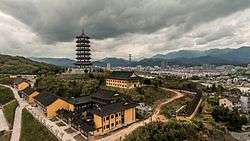Longquan
Longquan (simplified Chinese: 龙泉; traditional Chinese: 龍泉; pinyin: Lóngquán; lit.: 'dragon spring') is a county-level city and former county under the administration of the prefecture-level city of Lishui in southwestern Zhejiang Province, China, located on the upper reaches of the Ou River and bordering Fujian province to the southwest.
Longquan 龙泉市 Lungchuan | |
|---|---|
 | |
 Longquan Location in Zhejiang | |
| Coordinates: 28°04′N 119°08′E | |
| Country | People's Republic of China |
| Province | Zhejiang |
| Prefecture-level city | Lishui |
| Township-level divisions | 3 subdistricts 8 towns 7 townships 1 ethnic township |
| Seat | Longyuan Subdistrict (龙渊街道) |
| Elevation | 195 m (640 ft) |
| Population | |
| • Total | 270,000 |
| Time zone | UTC+8 (China Standard) |
| Postal code | 323700 |
| Area code(s) | 0578 |
Called Longyuan (龙渊) before the Tang dynasty, Longquan adopted its current name because of the naming taboo of Emperor Gaozu, the founder of Tang whose personal name was Li Yuan (李渊).
Demographics
Longquan has a population of around 270,000.
There is an Ethnic Township set aside for the She-nation minority at Zhuyang (竹垟).
Celadons and swords
Longquan is famous locally for its swords and Longquan celadon ceramics, both of which are often regarded as historically the finest in China. Longquan celadon was one of China's finest ceramics from the Song dynasty until it fell out of fashion in the Imperial court during the Ming dynasty. Production continued but at lower quality. The swords made in Longquan (Longquanjian) are famous among martial artists in China. Modern sword production is now led by a workshop named "Shenguanglong" whose sword-making history can be traced back to the twentieth year of Guangxu in the Qing Dynasty. There are several private and state-owned swords-making factories in Longquan.[1]
Industry
The city has a static inverter plant of HVDC Three Gorges-Changzhou.
Administration
The city's executive, legislature and judiciary are at Longyuan Subdistrict (龙渊街道), together with the CPC and PSB branches. The other divisions, numbering two subdistricts, eight towns, seven townships and one ethnic township, are as follows:[2]
Subdistricts:
- Xijie Subdistrict (西街街道), Jianchi Subdistrict (剑池街道)
Towns:
- Badu (八都镇), Shangyang (上垟镇), Xiaomei (小梅镇), Chatian (查田镇), Pingnan (屏南镇), Anren (安仁镇), Jinxi (锦溪镇), Zhulong (住龙镇)
Townships:
- Lanju Township (兰巨乡), Dashi Township (跶石乡), Baoxi Township (宝溪乡), Longnan Township (龙南乡), Daotai Township (道太乡), Yanzhang Township (岩樟乡), Chengbei Township (城北乡), Zhuyang She Ethnic Township (竹垟畲族乡)
References
- "A cutting-edge sword-making legacy". China Daily. Retrieved 2019-01-06.
- 2011年统计用区划代码和城乡划分代码:龙泉市 (in Chinese). National Bureau of Statistics of the People's Republic of China. Retrieved 2013-01-04.